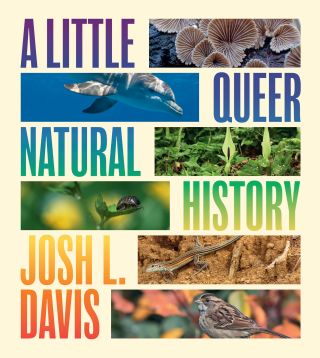Source: Jason Auch/Wikimedia Creative Commons
Many people, including researchers and people who are simply interested in animal behavior, have written off queer sexual behavior in nonhuman animals for any number of reasons, including that it is offensive or so rare as to be meaningless. However, times are changing, and science writer Josh Davis’s fascinating new book A Little Queer Natural History explains how queer animals and plants not only aren’t rare but are rather common, and studying their behavior more closely can open our eyes and hearts to the astonishing diversity of sexual behavior and biology found in nature. His book reminded me of another fascinating book called Queer Ducks (and Other Animals): The Natural World of Animal Sexuality by bestselling author Eliot Schrefer in which the idea that same-sex sexual behavior is “unnatural” is fueled by an overly narrow view of natural selection and that thousands of animal species have demonstrated same-sex sexual behavior.
Here’s what Josh had to say about his riveting new book.
Why did you write A Little Queer Natural History, and how does your book differ from others that are concerned with some of the same general topics?
About five years ago, I co-produced and led the Natural History Museum’s first-ever LGBTQ+ natural history tour. Since then, I’ve been researching and writing about queer natural history for various outlets.

‘A Little Queer Natural History’ by Josh L. Davis
Source: University of Chicago Press/Used with permission
One of the things that stuck with me most was that this fascinating information was out there, just often in disparate books, papers, and various parts of the internet. Almost every time I delved into the subject, I’d come across something else new and interesting and could never quite remember the convoluted path that took me there. Other times, I’d find out some amazing facet of biology but be unable to unearth a simple, easy-to-understand explanation of how it worked.
I also found that there are surprisingly few accessible books out there on this topic. Those that do exists are either academic textbooks (Biological Exuberance) or aimed at a younger audience (Queer Ducks and Other Animals). So, my main motivation for this book was to create the resource I needed back when I started.
I wanted to create an almost one-stop shop, giving individual examples of the kaleidoscopic diversity of non-heteronormative behaviors found in the natural world. This book isn’t a comprehensive list of gay animals, and it was never intended to be. I hope instead that A Little Queer Natural History is simply a starting point and that it will spark interest and send readers on their own queer natural history journey.
How does your book relate to your background and general areas of interest?
I’m a biologist by training, who sort of accidentally fell into science writing. I studied zoology at university and then spent time as a research assistant working with western lowland gorillas.
I guess I’m just a curious person, and I like to ask a lot of questions (which serves studying biology and being a science writer equally well!). When it comes to natural history, many unanswered questions often relate to sex.
And even then, those things we do know about sex typically only refer to heterosexual sex. It could be argued that that is because this is what leads to the next generation, but I think it is pretty clear (and history tends to show us) that it is also down to human biases against queer behaviors and animals, whether implicit or explicit.
So, as I started researching these topics for the Museum LGBTQ+ tour, I naturally got drawn in and became fascinated by how these species are behaving, why, and, perhaps most interestingly to me, how people have controlled and edited this information over time.
Who do you hope to reach in your interesting and important book?
Generally, I’d love for as wide an audience as possible to read this book. I think most people have heard of gay animals (usually via penguins), but it has often been treated as the punchline to a joke. I’d love for people to fully understand how widespread and natural these behaviors actually are.
More specifically, however, I’d like behavioral biologists and zoologists to read this book and maybe reflect on how they talk about the behaviors and biologies they observe and whether they are inadvertently perpetuating biases.
Animal Behavior Essential Reads
What are some of the major topics you consider?
There were a few major themes that came to the surface while I was researching and writing this book.
The first of these was around just how many species display some form of same-sex behavior. The often-quoted figure is around 1,500 species, but as soon as you scratch the surface of this statistic, it becomes patently obvious that this is a gross underestimate.
This is because as soon as you start to map out where queer species are on the evolutionary tree, it shows that everything from squids and spiders to bats and birds has been found to engage in same-sex behaviors. And as it is highly unlikely to have evolved independently in so many branches, the obvious conclusion is that most—if not all—species display some form of queer behavior, and it is more unusual to be a purely heterosexual species.
Another strand was about the history of this subject. Over and over, it was shown how these behaviors have been observed for centuries, and yet they have frequently been dismissed, disparaged, and explained away. While some of this may have been unconscious or accidental, there is clear evidence that in some cases it was an active choice.
Finally, what seemed to unite many themes was that of language. We often like to think of science as being objective, but the language often used to describe queer behaviors, historically and in some cases recently, is frequently tinged with bias. This can take the form of moral or judgemental terminology when talking about queer natural history.
Are you hopeful that as people learn more about this most important topic, they will gain a better understanding and acceptance of the diversity of sexual behavior among nonhuman animals?
Totally! One thing that has come out again and again when talking about this book is that most people just have never realized that queer behaviors are so common and widespread. And as soon as you start talking about this and how our understanding of it has been covered up and controlled, they come to understand how normal and natural it actually is.
Source link : https://www.psychologytoday.com/za/blog/animal-emotions/202409/queer-nature-celebration-of-diverse-animal-sexual-behavior
Author :
Publish date : 2024-10-09 14:50:25
Copyright for syndicated content belongs to the linked Source.





